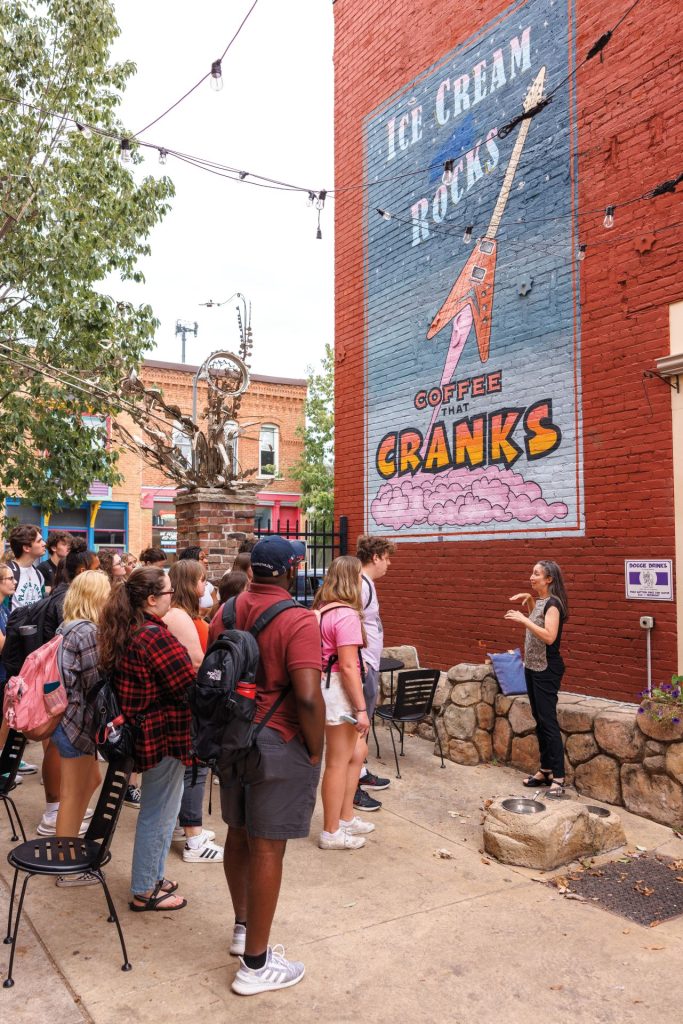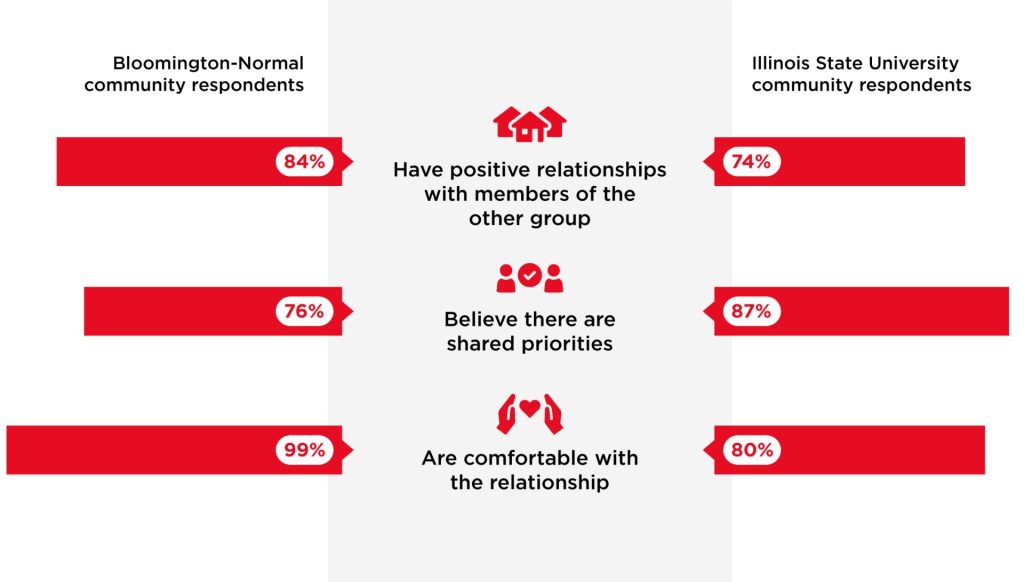Students enrolled in a class last fall studied a phenomenon to which they and all Illinois State University students before them have contributed.
“Studentification is a fancy word, and it’s a hard one to say,” said Dr. Harriett Steinbach, M.S. ’05, one of the course’s co-instructors. “I just describe it as all the positive and negative things resulting from the presence of a college and college students in a town.”
Appears InStudentification of Normal was an Advanced Honors Seminar that ran for the first eight weeks of the fall semester. Though the class was scheduled to meet once a week for 110 minutes in Stevenson Hall, students spent little time there. Instead, they attended the Sweet Corn Circus, a town council meeting, and a meet-and-greet with local government leaders. They toured Uptown Normal and the Constitution Trail. They rode a Connect Transit bus together.
“Studentification is a fancy word, and it’s a hard one to say. I just describe it as all the positive and negative things resulting from the presence of a college and college students in a town.”
—Dr. Harriett Steinbach, M.S. ’05
“I was expecting to be in the classroom for two hours, and I was kind of dreading that,” said Dominique Robinson, a sophomore from Tampico majoring in communication sciences and disorders. “But we went out and did a lot of things I never thought I’d do in college.”
The idea for the seminar came from Steinbach, an assistant director in the Center for Civic Engagement last fall who has since moved into a director role in Research and Graduate Studies after earning a doctorate in public administration. Steinbach’s doctoral dissertation was written on town and gown relations, a focus of her work in Illinois State’s Center for Civic Engagement and, before that, the Dean of Students Office.
Seeking balanced representation from both the University and its host community, Steinbach sought a co-instructor who could speak to the other half of town and gown relations. She found that person in Mercy Davison, a former Illinois State student who has been the Town of Normal’s town planner since 2004.
“These are things I’ve been talking about with students for the past 20 years,” Davison said.
Steinbach and Davison delivered short lectures to discuss the physical, cultural, social, and economic manifestations of studentification, but more class time was spent exploring the campus and surrounding community. After each “field trip,” students wrote reflections or participated in group discussions about the events. Steinbach and Davison answered questions and provided historical background and institutional knowledge.

“I think having both their perspectives was pretty essential to the course,” said JD Waldron, a junior computer science major from Springfield. “I think without either of them, it might have been one-sided.”
Students considered their personal contributions to studentification, but they also investigated previous generations’ impacts. Rapid growth in enrollment in the 1960s when the University expanded its academic offerings caused the student body to more than triple in size over the course of the decade. More recently, decreasing availability of on-campus housing has necessitated more off-campus housing and blurred campus boundaries.
Required reading for the seminar included key flashpoints for studentification, such as the 1970 “flagpole incident,” when students and local residents clashed over the former’s lowering of an American flag in honor of Malcolm X, and the 1984 “beer riot,” a large-scale student protest of local ordinances restricting large gatherings and the sale of beer kegs. “Nobody in the class knew about that,” Robinson said of the latter.
Those incidents stand out in the collective memories of the students and townspeople who lived them. Generation-spanning concerns about noise and alcohol—“lifestyle differences” Davison calls them with a wry smile—combined with those notable confrontations can form a perception that the studentification of Normal is driven by an adversarial relationship between Illinois State University and the Town of Normal.
Those positives include a diverse transit system that accommodates college students’ preference for alternative forms of transportation and contributions to culture and entertainment through art, music, and athletics, not to mention the economic benefit of nearly 21,000 students living in the community.
Normal Mayor Chris Koos shared his thoughts on town and gown relations at the meet and greet with local government attended by seminar students. “He said what’s good for ISU is good for Normal, and what’s good for Normal is good for ISU,” Robinson recalled.
Presenting at the International Town and Gown Association’s national conference a few years ago in Chicago, Davison was surprised to learn of other towns’ relationships with colleges and universities in their communities.

“I thought it was common practice to have strong relationships and positive back-and-forth with each other,” she said. “But a lot of times, it’s antagonistic—or neutral or tolerant, at best.
“So, the level of collaboration that we have here is the envy of a lot of university communities.”
Perhaps there’s no better example of the studentification of Normal than the revitalization of Uptown Normal. The project that began in 1999 with a focus on creating a “there”—a thriving town center destination—has been largely successful by economic and aesthetic measures.
“It’s hard to envision it working at this level without the University being right next door,” Davison said. “You can make an investment like this when you know you have 21,000 students and 3,500 faculty and staff right next door.”
Illinois State has a greater presence in Uptown than the former Downtown Normal. University offices and events make Uptown feel like an extension of campus.
“When I was a student, there were people who literally never crossed Fell Street,” Davison said. “Now, I see students here all the time.”
Students in the seminar spent a portion of their penultimate class on a tour of Uptown led by Davison. Their final project due the following week was a written reflection of their experience in the class. They were asked to identify the positive and negative aspects of studentification and the ways in which studentification connected to their majors, fields of study, and career paths.
“It’s been cool to see how Normal and ISU have grown—and grown together—and collaborated on a lot of things that make life better for students and non-student residents.”
—JD Waldron
The desired learning outcomes from the seminar went deeper than learning about the concept of studentification. Steinbach and Davison hoped students would feel like equal members of the greater community and consider civic participation.
“Will they attend another city council meeting? Or serve on a board? Or take advantage of resources available to them?” Steinbach said. “We hope they left this class thinking differently about being college students in a college town.”
By the numbers

Illinois State University’s Center for Civic Engagement conducted the Optimal College Town Assessment (OCTA) last fall to better understand the relationship between the University and Bloomington-Normal community. Responses were received from 818 individuals who were asked to identify as a member of either the Illinois State or Bloomington-Normal communities. Those who identify as both were asked to select the one in which they felt a stronger connection.

